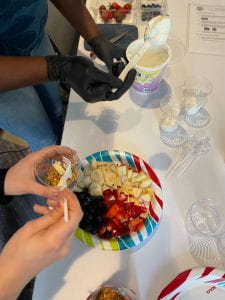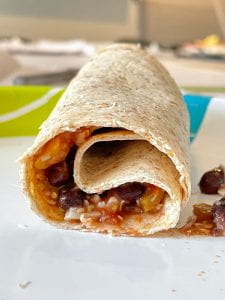This week me and the other CHFFF facilitators put our learning into practice by teaching back each of the six lessons to each other in pairs. My partner Sashana and I came up with some fun games for our teachbacks that I think went really well. The first lesson we gave was focused on “coloring your plate” with a variety of vegetables. Sashana suggested we add music – specifically “I Like to Move It” from the Madagascar movie – to the balloon game that the CHFFF handbook suggested for lesson 2. We did a pretty good job pretending to be 4th graders playing “keep it up” with the balloon while King Julian sang in the background, but I can’t wait to watch our actual students play the game next month. For this lesson we also got to make black bean salad, my favorite recipe of the CHFFF recipes I have tried so far. I decided to add cumin to spice it up and it turned out great!

For the next lesson about “making half your grains whole” Sashana found a great video of how a whole grain is refined which definitely enriched the lesson (couldn’t help but add a grain-related pun to this post!). We also played a fun game called “Stretch As If” where everyone has to move their body like how they imagine an animal of their choosing would stretch.

For our last teachback lesson called “power up your day,” we did an activity comparing the fiber and sugar content of different kinds of cereals. Teaching about nutrition facts labels is really my sweet spot (last pun I promise); I have always been fascinated (and frustrated) by how food companies can say almost anything they want about their product even if it’s not really true. For example, because there is no FDA-regulated definition of the term “natural” on food packaging, companies can claim their product is “natural” even if it is made with copious amounts of food processing, sweeteners, or preservatives. For this reason, I think it is really important people are empowered from a young age to unpack the Nutrition Facts panel because that is where the real information about a product is found. I am excited to oversee lessons about how to evaluate the Nutrition Facts panel this summer.




